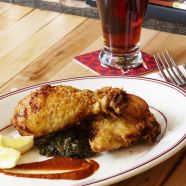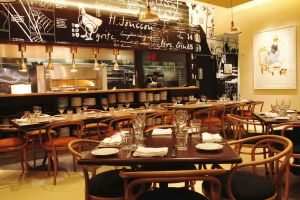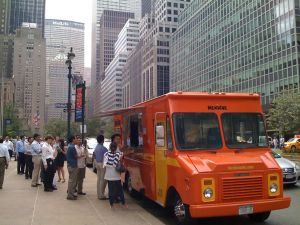
Fried Chicken at Red Rooster in Harlem, New York, Photo by Paul Brissman
Share This
Print This
Email This
It’s a Southern Fried World
America has long been called a “food nation,” and not always in the most flattering way. In recent years, however, a true foodie culture has cropped up with unofficial headquarters in cities across the country. Portland, Austin, and New Orleans stand out, but New York City remains at the forefront thanks in large part to its incredible diversity and the “seen it all before” attitude of the people who live there. Several culinary trends, notably gourmet food trucks and farm-to-table cooking, have shaped the New York dining experience in recent years. Good food is no longer reserved for the white tablecloth restaurants of the elite. Perhaps surprisingly, some of the best meals to be had in New York City are served out of the backs of converted postal service trucks and from counters at deceptively dingy storefronts in off-the-beaten-path neighborhoods. With the advent of Twitter, foodies can follow their favorite chefs in real time, and a genuine community has emerged that embraces the exchange of food-related opinions, influences, and ideas across cultural and socioeconomic backgrounds. No longer content with single moniker identifiers, New York’s food lovers are flocking to restaurants that can only be described in multi-hyphenate form. The melding of flavors and techniques happening in the kitchens of these restaurants is impressive and delicious. Take a tour of some of New York’s hottest dining destinations and your palate will be tricked into believing it’s on an odyssey around the world. You may be confused, however, by a certain subtle consistency across these global plates: a decidedly southern flavor shines through.
What defines “southern flavor”? This is not an easy question to answer, and perhaps the breadth of responses you would get if you posed this question to food lovers south of the Mason-Dixon Line gives a good indication of why southern flavors are so popular among an enormous range of otherwise “global” chefs in the North. Tidewater, Appalachian, Cajun, Creole, Lowcountry, and Floribbean are just a few of the names used to identify distinctly southern cooking. As Mississippian Craig Claiborne, the groundbreaking New York Times food editor and restaurant critic explained in his cookbook Southern Cooking, “It is not a question of chauvinism, but I have always averred that southern cooking is by far the vastest and most varied of all traditional regional cooking of the nation . . . An encyclopedic, exhaustive study of all Southern dishes would, of necessity, demand a number of books sufficient to fill a library shelf, and more.” Although southerners are passionate about food and intensely loyal to their particular local brand of southern cooking, a few traits emerge that help to define their cuisine as a whole. Southern food is closely tied to the very soil that makes up the South. Interestingly, in attempting to define southern food, Atlanta Journal-Constitution food writer John Kessler employed a global analogy in an interview with CNN: “What do they say in Italian? Cucina povere—poor people’s cooking. What Southern food is, is that. It is food that is very close to the agrarian tradition. It’s close to the earth.” Sound familiar? This is pop culture locavorism in its original form. Another descriptor that is so often used to describe traditional southern cooking it’s become a synonym is “comfort food.” This spin on southern cooking has been so embraced by Americans all across the country that a number of chains have made their fortunes by identifying themselves as such, including Cracker Barrel, Kentucky Fried Chicken, and Popeyes.
Surveying the “menu” of foodstuffs and dishes that are identified as southern, it becomes difficult to distinguish between “southern food” and “soul food.” Soul food is primarily associated with African American culture and originates in the urban centers where soul music was born, particularly Chicago and New York. Interestingly, soul music derives from the blues and gospel music traditions, both of which have their origins in the slave songs of the South. Typical soul food includes fried chicken, corn bread, black-eyed peas, and barbeque. But these would also top the list of typical southern foods—so what’s the difference? Or more importantly, why the striking similarity? The answer lies in the South’s historical division of labor. From the antebellum era through the mid-twentieth century, the southern kitchen was often the domain of African Americans. First as slaves and later as employees and entrepreneurs trying to make it on their own, many southern African Americans found work in kitchens across the region. Jessica Harris of Southern Foodways writes, “Whatever their lot, slaves did not simply cook for their own nourishment. They also cooked most, if not all, of the meals for the Big House, and their cooking in this arena resulted in the subtle but very real transformation of the tastes of the American South . . . like fried chicken, which calls on the West African art of frying; a host of fritters, which hark back to the African method of frying in deep oil; and a range of nut soups, went on to represent some of the best cooking the South had to offer . . . Finally in the sixties and seventies it came out of family kitchens to be celebrated as soul food or survival food.” The prominent role African Americans played in writing the recipe for what we now call down-home southern cooking explains the overlap between southern and soul foods, and highlights the inherently global nature of southern food as a culinary category.
African flavors and techniques were not the only influences that shaped what we now know of as southern food. In cities like New Orleans, the European influence is marked. Creole cooking centers on soups and stews of French origin, with Spanish influence apparent in the use of cooked onions, tomatoes and garlic. The southern baking tradition derives in large part from England. Although most of the responsibility for cooking was shouldered by African American slaves or employees, baking remained largely the domain of the white mistress of the house. The resulting platter of African and European flavors and techniques is incredibly unique, and acts as a common denominator among southern food subcategories from North Carolina to the Bayou. This mix is what makes it so easy to imagine today’s top chefs reaching for their grandmothers’ Junior League cookbooks when concocting a modern recipe for a decidedly “global” dish.
It’s no surprise, then, that a tour of restaurants and food trucks in Manhattan that self-identify as “southern” doubles as a journey around the world. The influence of global flavors on the history of southern food is well established: what’s interesting to discover now is the emerging influence of southern flavors and techniques on global foods served at New York City’s most popular foodie destinations.
Let’s begin our tour in northern Manhattan, in the heart of Harlem. The restaurant Red Rooster opened its doors on Harlem’s primary artery, 125th Street, about a year and a half ago. Since then, it has made a big impression not only on local eaters and tourists with a taste for mouthwateringly unique dishes, but also on the nation’s shapers of politics and culture. Red Rooster is helmed by Chef Marcus Samuelsson, whose biography is inextricably linked to his culinary career. Presumed an orphan at the age of three, Samuelsson traveled from Ethiopia to Sweden, where he was raised by his adoptive family. When asked by Garden and Gun magazine where his interest in southern food originated, he cited his Swedish grandmother Helga: “She used what I call ‘poor man’s cooking’ techniques to create a rich experience. I think that’s the root of Southern cooking . . . In the South, poor man’s cooking means not having the best piece of meat, but using everything you know to make it the most amazing meal. My first trip down South was to New Orleans. I remember eating and listening to this completely different vocabulary I’d never heard before.”
Samuelsson’s African origins, Swedish upbringing, and fascination with the “cucina povere” of the South define his menu at Red Rooster. This restaurant is a delicious medley of global and southern traditions. From the décor, where stylized Americana mixes effortlessly with Swedish artwork, to the menu, which features highlights like Fried Yard Bird and Helga’s Meatballs, Samuelsson has created a unique culinary experience. President Obama chose Red Rooster as a venue for a fundraiser recently, and reservations for average folks have to be made weeks in advance. Fundamentally, the flavors at Red Rooster are global. The curry shaker that comes with the Fried Yard Bird and the basmati rice and spices that make the “dirty rice” dish sing hit notes one might not expect at a southern restaurant. But the influence of the South is clear: the fried yard bird looks and clucks like fried chicken, but that doesn’t mean it is southern fried chicken—it’s something new entirely, and it’s worth making a trip back for.
Not all foodies are so impressed with Red Rooster. Eddie Huang, son of Taiwanese immigrants who settled in the South, penned an impassioned critique of the restaurant and what he perceives as an offensive insensitivity to the restaurant’s cultural milieu. Huang’s criticisms are rooted in race relations, once again pointing to the blurry line between “southern” food and “soul” food. Huang asked Michael Twitty, a culinary historian and blogger with a passion for African American foodways, for his insight into the Red Rooster phenomenon. Speaking from Louisiana, where he was concluding his “Southern Discomfort Tour,” Mr. Twitty cited “the one Negro syndrome.” In short, the theory goes, when a person of color excels, he automatically becomes the figurehead. Huang conceded that Samuelsson is “a supremely important global voice in America” but couldn’t see past the racial and cultural stereotypes he said he believes Samuelsson has employed to ill effect at Red Rooster.
Walking into the bathroom of the restaurant can feel like walking into a soul food museum, walls hung gallery style with photos of African Americans clapping in a gospel church and standing in front of old-timey soul food lunch counters. Perhaps, though, Huang missed what makes Red Rooster so fascinating: the next frame over contains newspaper clippings depicting a white child and a black child standing together with the Swedish headline “Blond en Brun,” and beside that hangs a vintage photograph of black and white diners gathered around a restaurant table. Red Rooster is a unique and laudable achievement because it genuinely serves up the “global South,” or perhaps more accurately the “southern globe,” on a plate that is guaranteed to be licked clean.
Mr. Huang’s distaste for Samuelsson’s take on soul food is of particular interest, because Huang deserves similar credit for reversing the original story of southern food: rather than employing global flavors and techniques to enhance a typical southern dish, Huang makes use of the southern spices and methodologies he grew up with to deliver a truly unique Taiwanese delicacy. He opened his own restaurant, Baohaus, located on chaotic 14th Street, a year after Samuelsson first unlocked Red Rooster’s doors. Huang, a former attorney, has earned mixed reviews from critics. The New York Times filed a critical review of Huang’s now defunct restaurant Xiao Ye in 2010, but Huang’s signature baos (Taiwanese sandwiches) have nevertheless maintained a devoted following. The menu at Baohaus is limited, but Huang has given serious thought to the composition of each dish offered. Although Huang has stated that he’s “not a chef,” the tasty takes on the Taiwanese classics he offers at this takeout counter suggest otherwise.
So what makes a New York-based Taiwanese bun shop “southern”? The influence is subtle but distinct. Huang was raised in Virginia and Florida and acknowledges the impact his upbringing had on his deceptively “global” cooking in a Southern Foodways Gravy interview, remarking that “the flavors [exemplify the influence of his Southern upbringing on his cuisine] . . . [He has] a heavier hand than most Chinese chefs, but Taiwanese cooks have an island flavor profile that’s heavy with pork fat, dried shrimp, and bamboo—and that really fits what [he] learned down South.” This spice-rack generosity really shines through in dishes like the Chairman Bao and the Birdhaus Bao. The former, which features pork belly braised in cherry cola served with crushed peanuts, ciantro, relish, and Taiwanese sugar, is delectable with almost indistinguishable southern and Asian notes. The Birdhaus, featuring fried chicken with similar fixings, shines a spotlight on one of the most cherished southern dishes without pretending to be southern. Huang’s offerings are Taiwanese, but the influence of southern culinary culture is unmistakable.
Walking out of Baohaus west toward Union Square, an epicenter of New York City’s multicultural identity, one might notice a brightly colored truck idling by the sidewalk across from the park. As at Baohaus, to get a taste of what’s being offered means waiting in a long line of in-the-know New Yorkers with an appetite for southern food with a global twist. Mexicue, a mini-chain that now includes one mobile truck and two brick-and-mortar shops, was founded in 2010 by David Schillace and Thomas Kelly. The concept came naturally to the pair when they started brainstorming ways to take advantage of New York’s explosion of mobile establishments. “This is the type of food I love cooking at home,” Kelly said in an interview for this article. “When Dave and I started thinking about concepts for a food truck and fast casual restaurant, we realized that this particular fusion really hadn’t been done before, which made it even more attractive.” The food truck model allowed these young partners to put their creative concept into practice with minimal start-up costs, but ultimately they’ve found that food trucks work better as a marketing tool than a cash cow. Since their early days on the road, the pair have opened two restaurants purveying their signature blend of “red-hot Mexican, down-home barbecue goodness,” as their tagline goes. When asked to define southern food and culture, Kelly boiled it down to one simple word: “comfort.” The menu, with a primary focus on that Mexican staple, the taco, consistently brings southern charm to the fiesta with fillings like oak-smoked short ribs and pulled pork shoulder. When asked to expand upon the dueling flavor profiles, Kelly remarked, “We really make an effort to infuse equal parts of each culinary tradition in all our items. There’s also a lot of overlap that exists already, which makes our job easier.”
The melting pot in which southern food has simmered for decades, if not centuries, has always been seasoned by global cuisines. Southern food has recently emerged as a popular food category in New York City, but a closer look at many of the city’s most-frequented establishments reveals a phenomenon that carries on the legacy of the genesis of southern food while also reversing the story: in the food capital of the nation north of the Mason-Dixon Line, global foods are benefiting from the flavors, techniques, and philosophies that have long been the bread and butter of humble chefs in home kitchens and restaurants throughout the South. Signature dishes of such far-flung places as Stockholm, Taipei, and Mexico City have never tasted better, and for that, New Yorkers have the South to thank.









0 Comments
Trackbacks/Pingbacks